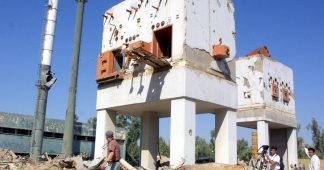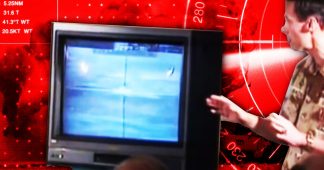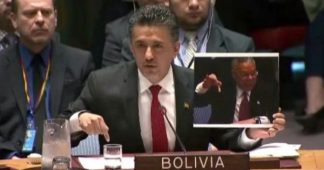WikiLeaks, April Glaspie, and Saddam Hussein
I’m generally not inclined to take issue with my FP colleagues, but David Kenner’s recent posting on the WikiLeaks release of a cable recounting Saddam Hussein’s infamous meeting with U.S. ambassador April Glaspie deserves a response. In an article headlined “Why One U.S. Diplomat Didn’t Cause the Gulf War,” Kenner argues that the new release …
By Stephen M. Walt
I’m generally not inclined to take issue with my FP colleagues, but David Kenner’s recent posting on the WikiLeaks release of a cable recounting Saddam Hussein’s infamous meeting with U.S. ambassador April Glaspie deserves a response.
In an article headlined “Why One U.S. Diplomat Didn’t Cause the Gulf War,” Kenner argues that the new release shows that Glaspie should not be blamed for the U.S. failure to make a clear deterrent warning to Saddam. And that is what he accuses me and John Mearsheimer (and the Washington Post) of doing. In his words, “the Washington Post described her as ‘the face of American incompetence in Iraq.’ Stephen Walt and John Mearsheimer piled on in a 2003 article for Foreign Policy, arguing that Glaspie’s remarks unwittingly gave Iraq a green light to invade Kuwait.”
I agree that the WikiLeaks release may exonerate Glaspie for being personally responsible for a diplomatic gaffe, but there are two problems with Kenner’s version of events.
First, we never accused Glaspie of diplomatic incompetence, and we certainly didn’t “pile on.” Here’s what we actually said in our 2003 piece:
In a now famous interview with the Iraqi leader, U.S. Ambassador April Glaspie told Saddam, ‘[W]e have no opinion on the Arab-Arab conflicts, like your border disagreement with Kuwait.’ The U.S. State Department had earlier told Saddam that Washington had ‘no special defense or security commitments to Kuwait.’ The United States may not have intended to give Iraq a green light, but that is effectively what it did.”
Notice that we offered no opinion on whether Glaspie was free-lancing, mis-reading Saddam, or simply following orders from Washington. Our article was focused on the issue of whether Saddam was deterrable, and the key issue that concerned us about the Glaspie meeting was whether she had conveyed a clear deterrent threat to Saddam, or whether she might have unintentionally given him reason to think he could go ahead and absorb Kuwait without facing a strong military response from the United States.
Second, a careful reading of the cable suggests that Saddam could have easily interpreted Glaspie’s conversation, along with other statements by U.S. officials, as a sign that the United States was not strongly committed to protecting Kuwait. For starters, the cable makes it clear that Saddam is at the end of his rope. He spends much of the conversation reciting a long list of grievances, and though his manner is described as “cordial, reasonable, and even warm,” he repeatedly accuses the United States of having malign intentions toward Iraq. For example, the cable refers to one of his “main points” being that the “USG maneuvers with the UAE and Kuwait. . .[and] encouraged them in their ungenerous policies.” And he makes it clear that his patience is not unlimited: “Iraqi rights, Saddam emphasized, will be restored one by one, thought it may take a month or much more than a year.” He also speaks of the “pride” of Iraqis, whom he says believe in “liberty or death,” and he warns that Iraq “will have to respond if the US uses these methods.” He adds that “Iraq knows the USG can send planes and rockets and hurt Iraq deeply,” but he “asks that the USG not force Iraq to the point of humiliation at which logic must be disregarded.”
How does Glaspie respond to Saddam’s litany of grievances, complaints, and not-very-veiled threats?
Her very first point in response is to thank him for the opportunity to discuss these matters directly, and she then says that “President Bush, too, wants friendship.” Her next point is to tell Saddam that “the President had instructed her to broaden and deepen our relations with Iraq,” and she reminds Saddam that though “some circles” might oppose that policy, “the U.S. administration is instructed by the President.” And then she adds that “what is important is that the President has very recently reaffirmed his desire for a better relationship” and he has shown that desire by opposing some sanctions bills.
In short, her initial response to Saddam is to try to reassure him of America’s friendly intentions, and to try to convince him that his suspicions are mistaken. It also seems clear that Glaspie is simply following the instructions she had been given.
Having begun by seeking to mollify Saddam, it is only then that Glaspie raises any concerns about what Iraq might be contemplating. Yet even here, she begins by first “stressing President Bush’s desire for friendship” and his desire for “for peace and stability in the Middle East. And then — finally — she expresses concern about bellicose statements by Saddam and his foreign minister and the movement of Republican Guard units. According to the cable, she asks: “Is it not reasonable for the U.S. to ask, in a spirit of friendship, not confrontation, the simple question: What are your intentions?”
Saddam says it is a reasonable question, and he acknowledges that this is even our “duty” as a superpower. But he quickly returns to his list of grievances, and says he’s tried everything to resolve his problem with Kuwait. He subsequently leaves the room to take a phone call, and returns with the encouraging news (from Egyptian President Mubarak), that the Kuwaitis have agreed to further negotiations. The meeting then ends on a friendly note, but when Saddam raises the question of his border dispute with Kuwait, Glaspie responds that “she had served in Kuwait 20 years before; then as now, we took no position on these Arab affairs.”
What are we to make of all this? As noted, it seems clear that Glaspie didn’t bungle her assignment: She was doing what the Bush administration wanted at this crucial meeting. In that sense, the headline on Kenner’s piece is correct: She’s not to blame for the war. Of course, neither Professor Mearsheimer nor I ever said she was.
The more interesting question — and the one that concerned us when we wrote our original 2003 article — was what that meeting tells us about Saddam’s calculations. I think the recently released cable describing that meeting is consistent with our interpretation. Saddam is clearly aggrieved, and most of Glaspie’s responses are attempts to mollify him. Nowhere in this cable is there evidence of a clear deterrent warning, or an unambiguous statement of an American security guarantee to Kuwait. She reminds Saddam that we have concerns about his intentions — which was clearly not news to Saddam — but there’s not even a hint from her of what Washington would do if he seized Kuwait.
Even Glaspie’s statement that President Bush is deeply interested in peace and stability in the Gulf can be read as something of a green light. If the president says he wants closer relations with Iraq but doesn’t want war in the Gulf, might Saddam have seen that as suggesting that the United States wasn’t about to fight to preserve Kuwaiti sovereignty? Remember: Saddam wasn’t intending to fight a major war against Kuwait; he was just planning a coup de main. Based on Glaspie’s remarks, he might easily has concluded that Washignton would ultimately acquiesce-however reluctantly — to his fait accompli.
In short, I think it is clear from the cable that the United States did unwittingly give a green light to Saddam, and certainly no more than a barely flickering yellow light. Glaspie certainly didn’t make it clear to him what would happen if he used force against Kuwait. This is a case of policy failure but not deterrence failure, in short, because deterrence wasn’t tried in this case.
Lastly, this incident seems to be a classic illustration of a country applying what IR theorists describe as a “spiral model” remedy to a “deterrence model” situation. (In the “spiral model,” states are aggressive solely because they are insecure, and therefore reassuring them is the best way to avoid war. In the deterrence model, states are aggressive because they are simply greedy or ideologically driven, and the only way to avoid war is to pose a credible deterrent threat.) The Glaspie meeting reveals that U.S. leaders were concerned about about Saddam’s intentions, and the U.S. government tried to reassure him that we were friendly so that he won’t do something precipitous. What was needed, however, was a clear and explicit statement that an attack on Kuwait would be met with an American military response. Glaspie never uttered such a statement, and we all know what happened next.











